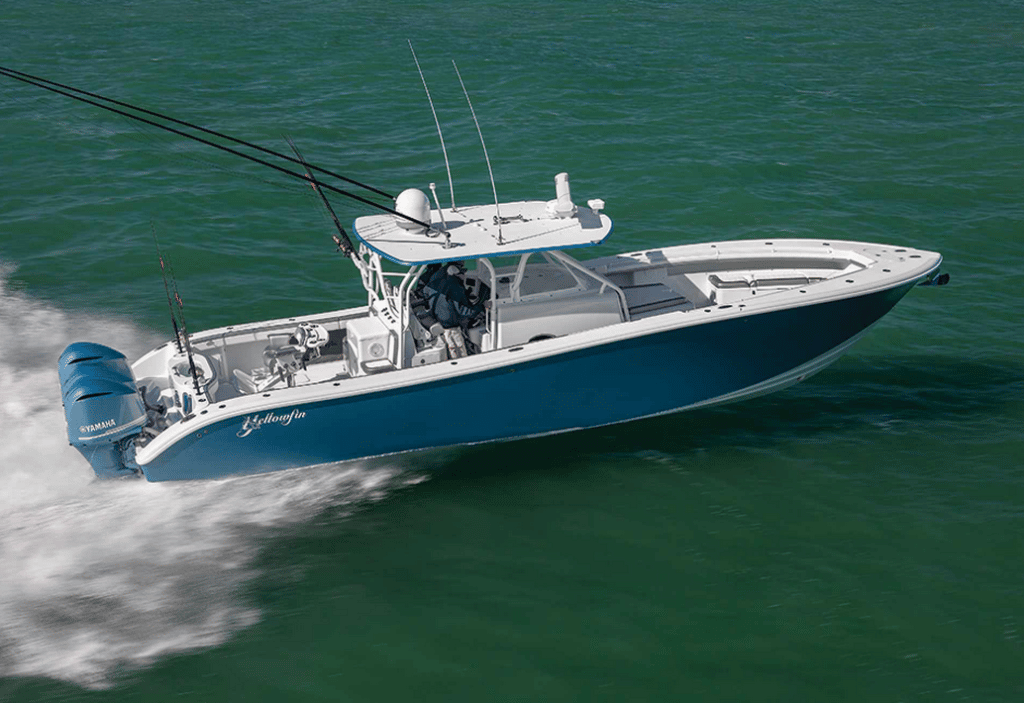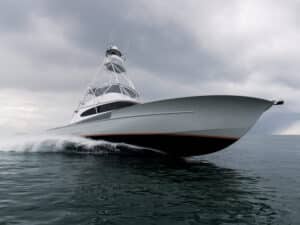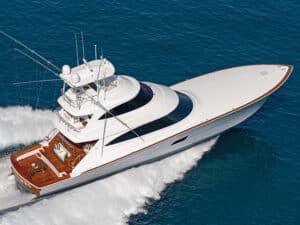
When I was growing up, a 25-foot outboard-powered center console was considered a big boat. These days, though, it seems the sky’s the limit on how big and fast that same type of boat can be. The new, powerful four-stroke outboard engines have been combined with modern hull designs and lighter-weight construction principles to produce boats that provide performance no one could have envisioned a few decades ago.
I experienced that new level of performance recently with Wylie Nagler, founder and president of Yellowfin Yachts, when we took a test ride aboard his company’s new 42-footer. Powered by triple 350-horsepower Yamahas, the boat comes up on plane with no appreciable bow rise, and in a matter of seconds, you’re loping along at 45 mph.
Nagler steered the 42 out of Big Sarasota Pass on Florida’s west coast at just such a speed, straight into a steep three- to four-foot chop whipped up by an approaching squall line. Being 42 feet long definitely helps in such a situation as the hull reaches across the troughs between waves, virtually eliminating any pounding. The 42 basically ignored the seas as we blasted past the sea buoy into the open Gulf of Mexico.
Yellowfin’s stepped-hull design introduces air onto the running surface, reducing friction and enabling faster speeds, and the 42 proved as nimble as its smaller siblings in the Yellowfin line. Like them, it also proved to be quite dry; the windy conditions and short chop we encountered during our test are the perfect combination to throw spray in your face when approached at the wrong angle, but the big Yellowfin kept spray to a minimum regardless of how we hit the waves.
Back in the protected waters of the bay, we let the big boat stretch out, hitting 62 mph wide open. It’s an exhilarating feeling traveling along at 60-plus miles an hour in a boat of this size, and it maneuvers with the agility of a much smaller vessel. Envision a giant Porsche, maybe.
Although speed and ride set the 42 apart, that’s not the main story with this boat. At the core, it’s a no-holds-barred fishing machine, with features and amenities galore to make serious offshore fishermen happy. In the cockpit, you’ll find two huge in-deck insulated fish boxes, port and starboard — those are the small ones. The really mammoth box lies forward of the console; that one holds 530 quarts. All of them drain via macerators.
A fully customizable rocket launcher sits at the forward end of the cockpit. Want another huge livewell to complement the 80-gallon well that comes standard in the transom bulkhead? No problem. Or you can outfit the space as a massive tackle storage area — it’s up to you. Our test boat’s unit featured two aft-facing seats with three large tackle drawers beneath a rigging station.
At the helm, we found bolster-style seating for three people, with fold-up/fold-down backrests for easy driving whether you’re sitting or standing. A large electronics-mounting surface above the helm had plenty of room to accommodate the two 19-inch Simrad NSO displays mounted there — a truly outstanding setup.
The centered helm offered great visibility in all directions, and all 12-volt operations on the boat were run through the CZone digital-interface system from New Zealand. This innovative system eliminates all switches, instead allowing the operator to turn things on and off electronically through a single CZone display screen, or through an interface with the Simrad system. It’s a very slick way to do things, once you get the hang of it, and it comes with a fail-safe backup system in the unlikely case of an electronics failure.
Beneath the console lie two six-foot-six-inch berths, extending forward beneath the foredeck. There’s a full marine head — standard equipment — and a shower as well, plus a flat-screen-TV option.
On the forward end of the console, a large sun pad sits atop a big storage box –– great for holding loose gear –– that opens on gas rams . But the entire bow area is about storage, with boxes beneath the forward wraparound seats, and two subdeck storage boxes outboard of the aforementioned fish box, and a third in front of it in the deck. There are even tilt-out bins in the hullsides that are perfect for holding items like dock lines. At the bow, an anchor receiver held a stainless-steel plow anchor, and the forward anchor locker contained an optional windlass.
The 42 excels at another type of storage too: rod storage. I already mentioned the 14 rod holders around the forward sun pad; there are six more atop the transom bulkhead, four in the rocket launcher, and three under each gunwale. That’s 32 rods before you ever install a single holder in the covering boards. On our test boat, the owner had opted for 10 per side, bringing his rod-storage capacity to 52. That ought to do it.
The Yellowfin 42 isn’t the only huge outboard boat on the market; in fact, these boats seem to be popping up with ever-increasing frequency, but it’s easy to understand the attraction. The ability to run hard in substantial seas and cover lots of ground when others are at the dock appeals to many of us. And with the Yellowfin, you get peace of mind in knowing that the company’s construction methods are state-of-the-art, using high-tech coring materials, all blended together into Yellowfin’s famous level of fit and finish.
These are good things to have when you’re far from the sight of land and the wind’s blowing hard. The Yellowfin 42 was built just for those of us who like it that way.







